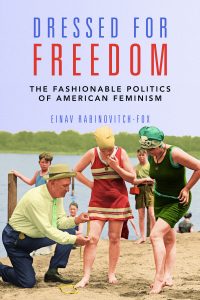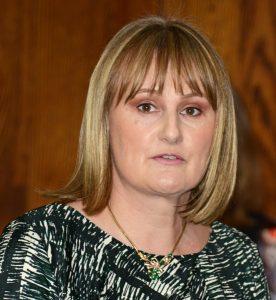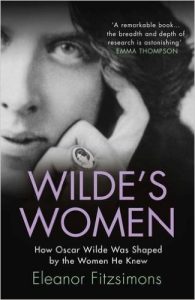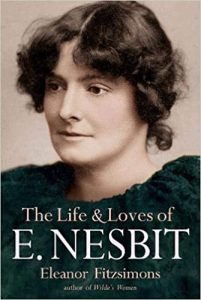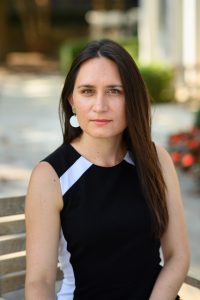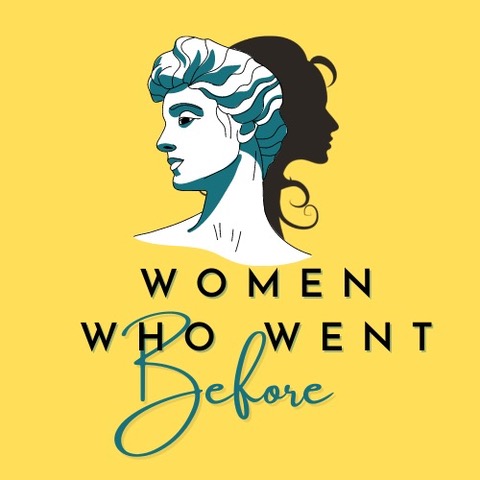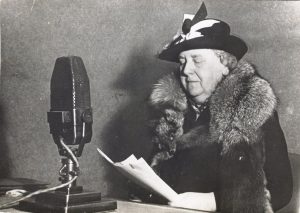Talking About Women’s History: Three Questions and an Answer with Einav Rabinovitch-Fox
Einav Rabinovitch-Fox is a modern U.S women’s and gender historian who teaches at Case Western Reserve University in Cleveland, OH. Her research examines the connections between fashion, politics, and modernity, particularly the role of visual and material culture in social movements. Her recent book, Dressed for Freedom: The Fashionable Politics of American Feminism explores women’s political uses of clothing and appearance to promote feminist agendas during the long 20th century. Her writing has been published in academic journals and books including the Journal of Women’s History, the International Journal of Fashion Studies, American Journalism: Journal of Media History, as well as popular media such as The Washington Post, The Conversation, Public Seminar, and History News Network.
Take it away, Einav!
We’re all familiar with the challenges of finding sources for writing about women from the distant past. What are the challenges of writing about women from the early to mid-twentieth century?
In a sense, the past is always a foreign country, and although we are less removed from the modern period, and are more familiar with it, I think some of the challenges remain. This is especially true when writing about women, as for so long, these histories were considered frivolous or not important, so I think that even when writing about women from the early to mid-twentieth century, there are still challenges in finding sources about them, or in finding sources that really center women’s voices and experiences. This is especially true with regards to women of color, working-class women, or other marginalized women, for whom there is still scarcity of sources.
Moreover, this sense of familiarity with the recent past can be deceiving. There is always the risk of interpreting things wrong or to draw conclusions based on our own experience and not necessarily on the experience of women in the past. Things have changed so dramatically in the life of women during the first decades of the twentieth century, that even for a woman living in the 1930s, the 1900s didn’t seem so liberating, not to mention for someone living in 2023. I always try to meet the women I write about where they are, to understand their world and how they were able to navigate it, and what challenges they had to overcome that maybe I don’t anymore.
Another thing to consider, especially when writing about more recent periods, is that the women I write about are perhaps still alive or have family members who are still alive. And while this is also true when writing about the distant past, I think that the real-life presence of women who lived in the recent past can bring more challenges to writing about them. I often feel I have more responsibility towards them to get the story right, but also to be more sensitive in how I tell their story. I also take into consideration what would be the repercussions of writing about personal or uncomfortable aspects of their lives. In that sense, it is the sense of familiarity that actually presents a challenge to distance yourself from the subjects of your writing.
Your work focuses on the way visual and material culture shapes and reflects class, race, and gender identities. What do we learn when we use images as more than just illustrations?
In a way, an image is just like any other historical source that can tell us something about the past. Especially when researching women’s history and other marginalized communities, what we often have is visual and material evidence, so it is actually a very important source to understand women’s history. Not many women left for us written records in the form of letters or diaries, but we can learn a lot about their everyday life and what they cherished and enjoyed from their dresses, embroidery, and small possessions.
Photographs, paintings, and illustrations contain a lot of information about the past, and so we need to learn to read them just like we read written sources. Material objects offer us even more information, as one can tell a lot when examining wear-and-tear of clothes, or use of other items. I think once we train ourselves to look at images more than just illustrations, but as historical sources, we can also begin to ask questions about them and discover that they can tell us a lot of things about the past.
What was the most surprising thing you've found doing historical research for your work?
Writing about fashion, I got to do research not only in archives but also in costume collections, which are archives made of dresses and other clothing articles and accessories. The most surprising thing about it is how different dresses look and feel like in real life, compared to an image or an illustration. Looking at an actual garment: How it is constructed, from what materials, as well as how much of it worn and torn, can tell you a lot not only about the piece itself, but oftentimes also about the person who wore it, as items that arrive to costume collections are almost never anonymous.
One of the most exciting finds are the times that you can match an actual dress to an image of the person who wore it, or a description of them wearing it and how they felt in this garment. Yet, exciting finds can also happen when you get to feel and touch the garment and understand better issues of comfort and proportions, something that often gets lost in images.
One example of that, which to me was very surprising, was when I got to see a bathing suit from the 1920s in one of the collections I visited, which was in Smith College. Bathing suits in the 1920s were quite revolutionary at the time, because they exposed women’s hips and shoulders and were very revealing of the body. It even caused some municipalities to try and ban them on the beaches as they were considered “inappropriate” and even “immoral.” Bathing suits were really the symbol of a feminist consciousness and liberation in the 1920s, so imagine my surprise when I got to touch it, and discover it was made from wool, maybe the last material I would like to go into the water dress in. Realizing that bathing suits were made of wool not only made me appreciate the invention of Latex, but also got me thinking differently about what comfort meant to the women who wore these suits and what made them so revolutionary, and how we today judge comfort.
Question from Einav: You write historical works for popular audiences, how do you make your audience care about women’s history? How do you show them that women’s history matters, that it is important?
When I was writing my dissertation, I had a day job that required me to work with a great many tradesmen, many of whom had doubts about taking instructions from me. (Probably all of them had doubts at the beginning. Some of them were simply more polite about it than others.) I changed their minds one guy and one project at a time.
In many ways, making readers care about women’s history is very similar. Other than this annual series of mini-interviews, I don’t try to make my audience care about women’s history in the abstract. Instead, I do my best to make them care about a particular woman or group of women or a specific story. Part of doing that is to make it clear why that story and that woman matter and how putting them back into the historical record makes our understanding of the past richer.
***
Interested in learning more about Einav Rabinovitch-Fox and her work?
Visit her website: www.einavrabinovitchfox.com
Follow her on twitter: @DrEinavRFox
***
Tomorrow it will be business as usual here on the Margins with a women’s-history- related blog post from me. (Subject to be determined.) But we’ve still got more people talking about women’s history from a lot of different angles next week. Don’t touch that dial!
Talking About Women’s History: Two Questions and an Answer from Eleanor Fitzsimons
Eleanor Fitzsimons is an Irish researcher and writer who specialises in historical and current feminist issues. She has an MA (first class honours) in Women, Gender and Society from University College Dublin. Fitzsimons is the author of Wilde’s Women: How Oscar Wilde Was Shaped by the Women He Knew (Duckworth, 2015). She is an honorary patron of the Oscar Wilde Society, and a member of the editorial board for society journal The Wildean. She has worked as a television researcher for the Irish national broadcaster RTÉ, and was a contributor to The Importance of Being Oscar (BBC2, April 2019). Her second biography The Life and Loves of E. Nesbit (Duckworth, 2019) was a Sunday Times Book of the Year 2019, and was included in the Washington Post Top 50 Non-Fiction Books of 2019 and the Dallas Morning News Top 100 Books of 2019. Her work has been published in several academic journals and books.
Take it away, Eleanor!
What do you find most challenging or most exciting about researching historical women?
In a sense, the aspect I find most challenging about researching historical women is also what makes this research most exciting and rewarding. I’m sure we’re all acutely conscious of the fact that women’s lives have often been very poorly documented. Where their experiences have been chronicled, this was often done through a gendered lens, their achievements undervalued or, if deemed worthy of commenting on, attributed to men. When researching my most recent biography, The Life and Loves of E. Nesbit, I discovered that many reviewers assumed Edith Nesbit was a man. One critic in The Graphic described her as “a man of rare poetic gifts and of true honest purpose”. Nesbit was fully aware of this confusion and occasionally found it funny. “All the reviewers took me for a man,” she told a friend, “and I was Mr Nesbit in the mouth of all men until I was foolish enough to dedicate a book to my husband, and that gave the secret away”. Literary women have often found it beneficial to disguise their identity, or even to write as men. Similarly, women who operated in traditionally masculine spheres, such as politics, science or medicine, were often castigated for not behaving as they should. In each case, you are required to challenge and evaluate what are often very biased accounts of their lives.
When we recover women’s lives, the challenge often lies in finding any information about them at all. The advantage of having to work harder is that those of us who write about women are obliged to seek out neglected primary sources – letters, diaries, census records, death certificates, court records such as bankruptcy proceedings, and accounts left by reliable family members and friends. I find this so rewarding and exciting. In a sense, I regard myself as a literary detective, a Miss Marple of the archives. When I wrote about Harriet Westbrook Shelley, first wife of Romantic poet Percy Shelley, who was completely overshadowed by his second wife, Mary, one of my better sources was a series of letters she exchanged with a remarkable Irishwoman named Catherine Nugent. Although she never married, Catherine felt obliged to pose as a widow and call herself “Mrs Nugent”. A male friend described her thus: “a wonderful woman—altho’ very plain, little and republican looking . . . Catherine Nugent has amazing spring and elasticity of mind, as if her mind made her forget that she had a weak body”. Both women are largely forgotten. Fortunately, their letters, with notes about Catherine’s life, were published by her friend Alfred Webb, a printer in Dublin, as Harriet Shelley’s Letters to Catherine Nugent. Such treasures are often buried in the archives but digitization of old books has ensured that they are increasingly accessible to us all.
What work of women's history have you read lately that you loved? (Or for that matter, what work of women's history have you loved in any format?)
There are so many worthy candidates! I’m going to choose a brilliant but unconventional book, A Ghost in the Throat by Irish poet and essayist Doireann Ní Ghríofa. Using beautiful, lyrical language, Ní Ghríofa intertwines her own experiences as a young mother in modern-day Ireland, with the story of Eibhlín Dubh Ní Chonaill, an Eighteenth-Century Irish noblewoman. On discovering her husband has been murdered, Eibhlín drinks handfuls of his blood and composes an extraordinary poem, Caoineadh Airt Uí Laoghaire, in his honour. Enchanted by this powerful poem, Ní Ghríofa becomes obsessed with uncovering the truth about the interior and exterior life of the shadowy woman who wrote it. The biographical details she uncovers are compelling enough, but what really sets this exceptional book apart is Ní Ghríofa’s extraordinary insights into the way we are shaped by our experiences, her enchanting exploration of language and ideas, and her celebration of the power of words to console and transport us. I cannot recommend it enough!
A question from Eleanor: I think Women's History Month is fantastic! What do you think the key achievement of the celebration of Women's History Month has been? Does it allow us to reach and retain an audience that would never normally take an interest in the lives and experiences of women?
As so many of us do, I have mixed feelings about Women’s History Month.
On the one hand, I wish that we didn’t need it: that’s women’s roles in history were simply an integrated part of how we think about history and the way history is taught. But that simply isn’t true: according to a statistic shared by the Remedial Herstory Project, in 2022 teachers spent between five and twenty percent of their history curriculum time on women’s history, with five percent being the plurality. (What do you want to bet that most of that five percent occurred during Women’s History Month?) That means that the mandate to teach and talk about women’s history in March remains important.
At the same time, I LOVE the festival feeling that surrounds Women’s History Month. Every year, I make new connections with other people who share my passion for this subject—here at History on the Margins and elsewhere. With each new connection, we amplify each other’s reach.
***
Want to know more about Eleanor Fitzsimons and her work?
Check out her website: https://eafitzsimons.wordpress.com/
Follow her on Twitter: https://twitter.com/EleanorFitz
***
Come back tomorrow for three questions and an answer with historian Einav Rabinovitch-Fox
Talking About Women’s History: Three Questions and an Answer with the Hosts of Women Who Went Before
Rebekah Haigh and Emily Chesley host and produce Women Who Went Before, a gynocentric podcast on the ancient world. Both are PhD candidates at Princeton University. Rebekah specializes in Religions of Mediterranean Antiquity and is writing a dissertation that explores gendered piety and violence in the Dead Sea Scrolls and ancient Judaism. Emily researches late antique history, and her dissertation examines women in the eastern Roman Empire amidst the military and religious upheavals of the 5th–8th centuries CE.
Take it away, ladies!
- Rebekah Haigh
- Emily Chesley
Photocredit: Sameer Khan/Fotobuddy, LLC.
What inspired you to start the podcast?
Rebekah: We certainly didn’t set out to start a podcast! It all began as a Covid project. In spring 2020 Emily and I had a conversation about why neither of us had spent much time thinking about women and gender in the ancient world. We realized it was a huge gap in our preparedness to be scholars, but there was a pandemic happening and there were no classes or library access. Then we thought “since, we're stuck at home … let's try starting a reading group.”
We weren't reading around specific historical women or texts about them. We were doing a lot of theory work work: looking at different waves of feminism and how they intersected with scholarship. It wet our appetite because when you do that kind of theory work, you're always trying to find connections like, “Okay, could I apply it to women that I'm familiar with? The historical texts I’m familiar with? I kind of want to try it.”
Emily: As it happened, it ended up being pretty popular. People joined from beyond Princeton, from different universities and even multiple countries. We realized that we weren’t the only ones who felt there was a gap in our education! And that shared enthusiasm fanned the flame.
Even people who weren’t enrolled in graduate programs heard about our group through social media and their friends, and they reached out. Ultimately their interest made us realize that this topic wasn't just of interest to people in the Academy; there is a hunger across society from people eager to learn about women in the ancient world. And then a conversation Rebekah had got us thinking towards a bigger picture.
Rebekah: At the end of that year, an administrator and mentor suggested turning our reading group into something more substantial, something that would reach that wider audience. As we brainstormed public scholarship formats, we assumed there were already a bunch of historical podcasts about ancient women. But while there were loads of podcasts on history, even ancient history, we couldn’t find anything on ancient women. Medieval women, women in 19th century America, but nothing about women in the ancient world. So we decided to make a podcast.
Emily: It's been a really rewarding journey so far! Our first season just finished, and we’re in preproduction for season two which will release in the fall.
Rebekah: And one of the first interviews we recorded for the podcast, with Solange Ashby on the warrior queens of Meroe, was someone who had participated in the original reading group!
What work of women's history have you read lately that you loved? (Or for that matter, what work of women's history have you loved in any format? )
Rebekah: Well, the answer that jumps to mind is going to reveal a lot about me and how I first came to love history – and also a lot about Emily. Both Emily and I have this shared experience of being home schooled with the same curriculum, one of the things we initially bonded over. We even read the same cluster of historical novels about women. One of which was Mara, Daughter of the Nile, a book that I’ve always credited for my early interest in ancient history. The novel was about this young girl who lived in Egypt. She's not a real person. But the book gave me a taste of what it might be like to live in the ancient world and I wanted to know more.
Emily: Historical fiction can powerfully engage you, whetting your appetite for “thicker” history books. Rebekah and I definitely shared a love rooted in a childhood of reading about women in history, whether real or fictional.
As far as books today, I have to caveat that as a grad student, I don't read as much pure history outside of work. I find I have to take a mental break and separate out the other kinds of reading from the work-reading (which yes, I also enjoy; and if you check the source lists for our episodes you’ll find many of my go-to academic texts on women’s history). I love to read for pleasure, but it’s usually fiction of some kind, whether YA or Dorothy Sayers or something in between.
Rebekah: Yes, exactly. I don't read much nonfiction beyond my own research. In my spare time, I want a break from heavier stuff, so I will usually read fictional stuff or sci-fi but not a lot of biographies of women.
Emily: One book both Rebekah and I read, which isn’t a history of the past so much but in a way is a history of our present, is Living A Feminist Life by Sara Ahmed. She does a wonderful job of linking academic work on feminist theory with lived women's experiences in a practical way. She applies insights from feminist scholars to help women, especially women of color and queer women, understand their own day-to-day lives and the resistance they receive from the world. One of Ahmed's famous ideas that recurs throughout her corpus is that when you point out a problem you become the problem, and it’s helped encourage me in moments advocating for gender equality in the workplace.
In terms of more traditional histories about women and still grippingly written, I loved Code Girls by Liza Mundy, and The Radium Girls and The Woman They Could Not Silence by Kate Moore. The latter is particularly moving; it’s about Elizabeth Packard, a 19th-century woman from Illinois whose husband institutionalized her, and it looks at the laws in that century that basically gave husbands complete control over their wives. Julia Cooke’s Come Fly the World is a history of the first jet-set stewardesses for Pan Am. I admit I was first intrigued by the topic (speaking of women’s history in other formats) because in college my roommates and I watched the short-lived TV series Pan Am, crowding onto our old couch every week and obsessed with the glamor of it all. Then reading this archival history, you can’t help but be struck by the indignities and sexism these women endured while breaking the glass ceiling and their fortitude in the first decades of commercial air flight.
This is in some ways an atypical women's history book because she is still alive today, but Nell Painter’s memoir Old In Art School also stands out. She’s an award-winning historian of African American history and race, and one of her most famous books was The History of White People. Then after she retired, she went to art school and started working as an artist. Her memoir describes that journey, exploring the links and tensions between her academic work and her art practice, and mulling on her experiences as an older black woman in the predominantly white and younger art world.
Rebekah: I can add a nonfiction book which I have managed to get halfway through, The Way of Perfection by Teresa of Ávila. The book is not a biography or a historical piece but rather personal reflections by a Spanish nun and mystic who lived in the 16th century. She was pretty radical for her time. Teresa led a monastic reform that made many people unhappy with her, but her writings have endured the test of time. The Way of Perfection is a book about prayer and meditation, how to be intentional about your spiritual life. Though written hundreds of years ago, it remains an insightful piece on practices of meditation, a topic that I've been interested in for a long time.
I think one of the reasons that her personal reflections, and works like it, still speak to everyday people is because in them we have access to women’s inner thoughts and feelings, something we don't usually have with the ancient world. There is a degree to which when we have access to what women are writing and what they're thinking, it's easier for contemporary history aficionados to identify with those figures and to find space for themselves and their stories.
What was the most surprising thing you've found doing historical research for your work?
Emily: Honestly, I think for me the most surprising thing was realizing just how much we actually know about ancient women, just how much research there actually is. Embarrassingly, I hadn’t read extensive scholarship on women’s history during college and graduate school because it wasn’t part of the core curriculum. I didn’t know all that was there until I began looking intentionally.
My introduction must have been in my final semester of seminary, when I took an elective on women in contemporary African Christianity and audited another class on medieval women, and those started to crack open the doors. Then, once your foot is in and you find, say, one article with robust footnotes, you can start following the trails. There are so many dedicated scholars unearthing stories and clues about pre-modern women through innovative detective work. The trails are rich and never-ending, and we’ve gotten to explore some for our podcast. I suppose that becomes the lesson –which, come to think of it, also applies to other areas of life– you have to choose to look.
Rebekah: Piggybacking on that, as an academic I find myself reading for things that I'm interested in, that intersect with my research on violence and ritual. If you're not looking for women, it's easy to overlook them. But, once I started thinking about questions of gender, especially once Emily and I had started the podcast, I started looking. Now as I'm doing my research, if I see a reference about a woman performing a ritual, I'm going to jot that down and go read about it. Because now that I am paying attention to women, I'm seeing texts and scholarship all over the place, usually in the footnotes. The surprising thing is that there are a lot more women than I thought there were.
It’s my sense, both from my students and also my own college experience, that learning about women in history is often regulated to a gender studies or topical class on women. You might get a course about women and magic, or women and sexuality. Or, perhaps women will appear as a topic for one week on a syllabus, or there might be a reading or two dedicated to them in a course otherwise dominated by historical men. I think we need to move beyond this tendency in academia to check boxes when it comes to teaching about ancient women or to limit student interest in women to certificate programs. Stop putting women in the footnotes.
Something one of our earliest podcast guests said has stuck with me, which is this concept of above and below the line in academic writing. Above the line is what’s written in the body of your paper, article, or book. This tends to be your thoughts and the thoughts of those you perceive to be the big name scholars - the people whose work you know really well. Everybody else goes below the line, in the footnotes. These conventions about which scholars “really matter” create a self-perpetuating cycle, so that other scholars (often women) keep getting relegated to the footnotes. This concept of above and below the line is really helpful for thinking about where we need to go with women's history and research about women. There’s so much great work being done about women in the ancient world, but it often goes overlooked. It’s still “under the line” in some sense. So it is not enough to start paying attention to women, we need to actively put them above the line. Which is what Emily and I try to do in our podcast, Women Who Went Before. We’re taking all this amazing research and making it more accessible to people who might not be hanging out in academic libraries trying to write a dissertation.
Emily: Or who lack a subscription to JSTOR! Many people might not have access to academic journals or research libraries, but they definitely are interested in learning about history and its women. That's where podcasts, blogs like yours, radio programs, TV series, historical fiction, video games, and more creative public scholarship come into play. And I’ll add lastly, it’s not just what scholars say and where, but also how we say it. To truly be accessible we need to communicate academic research and writing in emotive and engaging ways.
A question from Rebekah and Emily: What historical woman would you want to go back in time and meet, and how would you spend the day with her?
My first thought on reading this question was: So many women! How can I possibly choose?
My second thought was: Queen Wilhelmina of the Netherlands. Wilhelmina ascended the Dutch throne in 1898 at the age of 18. She was sixty when Nazi Germany attacked the Netherlands. She transformed herself from a stiff, shy, distant ruler to the heart of her country’s resistance. Hours after the German attack began, she made her first broadcast against the Nazis on Dutch radio. She made her next broadcast the day after she arrived in Britain. Every day thereafter, the the queen spoke to her people at the start of the Radio orange program broadcast to the Netherlands by the BBC. Her radio speeches were passionate and personal; with one exception, she wrote them herself. The Dutch joked that the queen’s grandchildren weren’t allowed to listen to her broadcasts from their refuge in Canada because she used such foul language when she talked about the Nazis.
As far as what we’d do: given my current project I’m in the mood to kick back and trash talk the Nazis over a dark beer.
Want to know more about Women Who Went Before?
Listen to the podcast: https://womenwhowentbefore.com/
Follow them on Twitter: https://twitter.com/womenbefore
Check out the podcast Facebook page: https://www.facebook.com/womenbefore
***
Come back tomorrow for two questions and an answer with biographer Eleanor Fitzsimons

